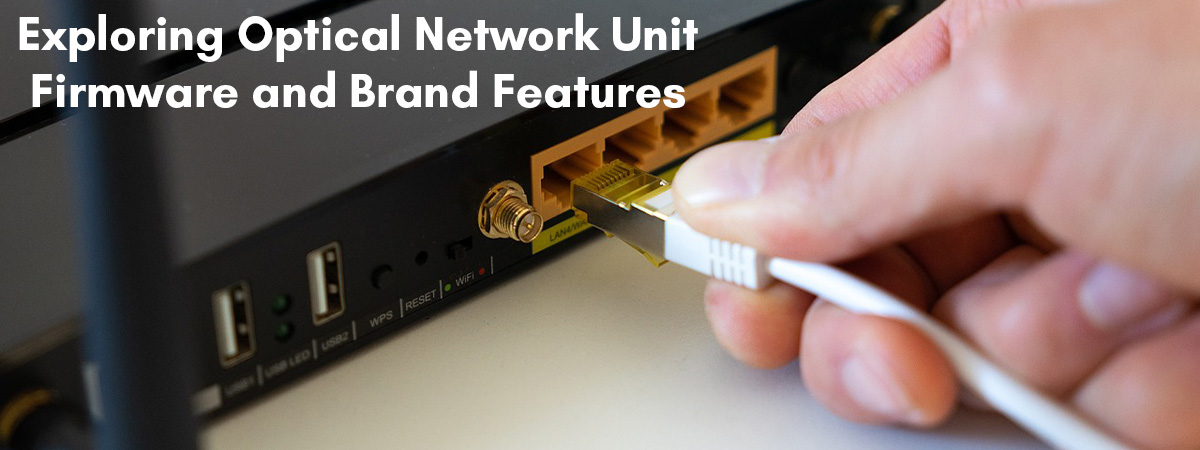Introduction:
In the vast landscape of telecommunications, the intricate interplay between hardware and software forms the backbone of connectivity. Optical Network Units (ONUs), integral components of modern networks, rely on firmware to orchestrate their functionalities and ensure seamless operation. In this comprehensive guide, we embark on a journey through the world of Optical Network Unit firmware, exploring its significance, functionalities, and impact on network efficiency and reliability. Additionally, we delve into the characteristics of ONU firmware across leading brands such as Huawei, ZTE, Fiberhome, and Nokia, unraveling their unique features and contributions to the telecommunications ecosystem.
The Magic of Optical Network Unit Firmware:
At the heart of every Optical Network Unit lies its firmware—a silent yet indispensable force driving the seamless transmission of data across networks. Optical Network Unit firmware serves as the operating system of ONUs, controlling their functionalities and ensuring efficient communication between network components. From managing network configurations to facilitating firmware updates, the importance of ONU firmware cannot be overstated in maintaining network stability and performance.
Functionalities of Optical Network Unit Firmware:
The functionalities embedded within Optical Network Unit firmware are diverse and multifaceted, catering to the intricate requirements of modern telecommunications networks. One of the primary functions is the management of network protocols, including Ethernet, GPON (Gigabit Passive Optical Network), and EPON (Ethernet Passive Optical Network), to facilitate data transmission and reception. Additionally, ONU firmware facilitates Quality of Service (QoS) mechanisms, ensuring prioritization of critical data packets for seamless service delivery.
Impact on Network Efficiency and Reliability:
The quality and reliability of Optical Network Unit firmware have a direct impact on network efficiency and reliability. Well-designed and optimized firmware enhances the performance of ONUs, minimizing latency, packet loss, and network downtime. Conversely, outdated or poorly implemented firmware can lead to network instability, security vulnerabilities, and suboptimal performance, affecting user experience and overall network integrity.
Challenges and Considerations:
Despite its critical role, developing and maintaining Optical Network Unit firmware presents various challenges and considerations. Compatibility issues with different hardware platforms, interoperability with network management systems, and ensuring compliance with industry standards are some of the key challenges faced by firmware developers. Moreover, the need for frequent firmware updates to address security vulnerabilities and introduce new features adds complexity to the firmware development lifecycle.
Future Trends and Innovations:
As telecommunications networks continue to evolve and adapt to emerging technologies, the landscape of Optical Network Unit firmware is also witnessing significant advancements. Trends such as Software-Defined Networking (SDN) and Network Functions Virtualization (NFV) are driving the adoption of agile and programmable firmware architectures, enabling dynamic network management and scalability. Additionally, advancements in Artificial Intelligence (AI) and Machine Learning (ML) are being leveraged to optimize firmware performance and enhance network intelligence.
Characteristics of Optical Network Unit Firmware Across Brands:
- Huawei Optical Network Unit Firmware: Renowned for its innovation and reliability, Huawei’s ONU firmware boasts a comprehensive suite of features designed to optimize network performance. With robust support for industry-standard protocols such as GPON and EPON, Huawei firmware ensures seamless interoperability with diverse network environments. Advanced Quality of Service (QoS) mechanisms prioritize critical data streams, while built-in security features safeguard against cyber threats, ensuring a resilient and secure network infrastructure.
- ZTE Optical Network Unit Firmware: ZTE’s ONU firmware embodies a blend of sophistication and versatility, catering to the dynamic demands of modern telecommunications networks. Characterized by its modular architecture, ZTE firmware facilitates seamless integration with third-party network management systems, enabling centralized control and monitoring. Enhanced fault detection and recovery mechanisms ensure rapid response to network anomalies, minimizing downtime and optimizing service availability.
- Fiberhome Optical Network Unit Firmware: Fiberhome’s ONU firmware stands out for its focus on scalability and flexibility, making it an ideal choice for evolving network architectures. With support for Software-Defined Networking (SDN) principles, Fiberhome firmware enables dynamic allocation of network resources, enhancing agility and adaptability. Advanced traffic management capabilities ensure efficient utilization of bandwidth, while integrated analytics tools provide actionable insights for network optimization and performance enhancement.
- Nokia Optical Network Unit Firmware: Nokia’s ONU firmware is synonymous with reliability and innovation, underpinned by decades of expertise in telecommunications technology. Featuring advanced network virtualization capabilities, Nokia firmware enables the deployment of virtualized network functions, streamlining network operations and reducing infrastructure costs. Seamless integration with Nokia’s end-to-end network solutions ensures interoperability and compatibility, empowering operators to deliver superior connectivity experiences to their customers.
Conclusion:
In the dynamic landscape of telecommunications, Optical Network Unit firmware stands as a cornerstone of network infrastructure, driving connectivity and innovation. Understanding the significance of ONU firmware, its functionalities, and its impact on network efficiency and reliability is crucial for network operators, service providers, and telecommunications professionals. By embracing future trends and harnessing the distinctive features of ONU firmware across leading brands, the potential for driving connectivity and innovation knows no bounds.
